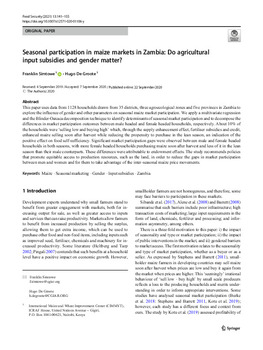Seasonal participation in maize markets in Zambia: do agricultural input subsidies and gender matter?
Abstract
This paper uses data from 1128 households drawn from 35 districts, three agroecological zones and five provinces in Zambia to explore the influence of gender and other parameters on seasonal maize market participation. We apply a multivariate regression and the Blinder-Oaxaca decomposition technique to identify determinants of seasonal market participation and to decompose the differences in market participation outcomes between male headed and female headed households, respectively. About 10% of the households were ‘selling low and buying high’ which, through the supply enhancement effect, fertiliser subsidies and credit, enhanced maize selling soon after harvest while reducing the propensity to purchase in the lean season, an indication of the positive effect on food self-sufficiency. Significant market participation gaps were observed between male and female headed households in both seasons, with more female headed households purchasing maize soon after harvest and less of it in the lean season than their male counterparts. These differences were attributable to endowment effects. The study recommends policies that promote equitable access to production resources, such as the land, in order to reduce the gaps in market participation between men and women and for them to take advantage of the inter-seasonal maize price movements.

